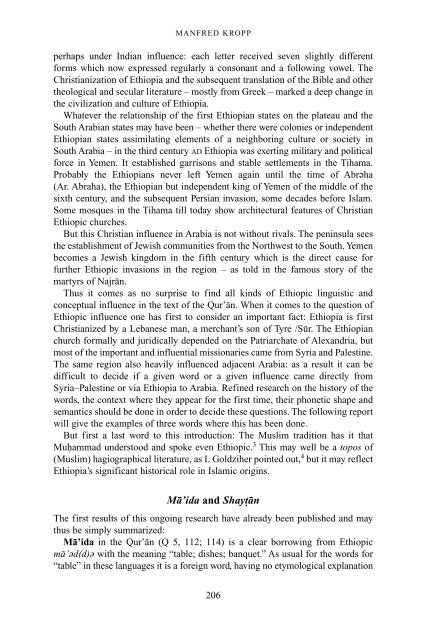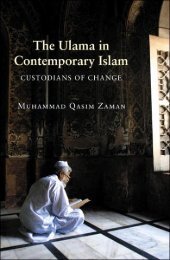The Qur'an in its historical context (pdf - Islam and Christian-Muslim ...
The Qur'an in its historical context (pdf - Islam and Christian-Muslim ...
The Qur'an in its historical context (pdf - Islam and Christian-Muslim ...
Create successful ePaper yourself
Turn your PDF publications into a flip-book with our unique Google optimized e-Paper software.
MANFRED KROPP<br />
perhaps under Indian <strong>in</strong>fluence: each letter received seven slightly different<br />
forms which now expressed regularly a consonant <strong>and</strong> a follow<strong>in</strong>g vowel. <strong>The</strong><br />
<strong>Christian</strong>ization of Ethiopia <strong>and</strong> the subsequent translation of the Bible <strong>and</strong> other<br />
theological <strong>and</strong> secular literature – mostly from Greek – marked a deep change <strong>in</strong><br />
the civilization <strong>and</strong> culture of Ethiopia.<br />
Whatever the relationship of the first Ethiopian states on the plateau <strong>and</strong> the<br />
South Arabian states may have been – whether there were colonies or <strong>in</strong>dependent<br />
Ethiopian states assimilat<strong>in</strong>g elements of a neighbor<strong>in</strong>g culture or society <strong>in</strong><br />
South Arabia – <strong>in</strong> the third century AD Ethiopia was exert<strong>in</strong>g military <strong>and</strong> political<br />
force <strong>in</strong> Yemen. It established garrisons <strong>and</strong> stable settlements <strong>in</strong> the Tihama.<br />
Probably the Ethiopians never left Yemen aga<strong>in</strong> until the time of Abr7ha<br />
(Ar. Abraha), the Ethiopian but <strong>in</strong>dependent k<strong>in</strong>g of Yemen of the middle of the<br />
sixth century, <strong>and</strong> the subsequent Persian <strong>in</strong>vasion, some decades before <strong>Islam</strong>.<br />
Some mosques <strong>in</strong> the Tihama till today show architectural features of <strong>Christian</strong><br />
Ethiopic churches.<br />
But this <strong>Christian</strong> <strong>in</strong>fluence <strong>in</strong> Arabia is not without rivals. <strong>The</strong> pen<strong>in</strong>sula sees<br />
the establishment of Jewish communities from the Northwest to the South. Yemen<br />
becomes a Jewish k<strong>in</strong>gdom <strong>in</strong> the fifth century which is the direct cause for<br />
further Ethiopic <strong>in</strong>vasions <strong>in</strong> the region – as told <strong>in</strong> the famous story of the<br />
martyrs of Najran.<br />
Thus it comes as no surprise to f<strong>in</strong>d all k<strong>in</strong>ds of Ethiopic l<strong>in</strong>guistic <strong>and</strong><br />
conceptual <strong>in</strong>fluence <strong>in</strong> the text of the Qur’an. When it comes to the question of<br />
Ethiopic <strong>in</strong>fluence one has first to consider an important fact: Ethiopia is first<br />
<strong>Christian</strong>ized by a Lebanese man, a merchant’s son of Tyre /Sur. <strong>The</strong> Ethiopian<br />
church formally <strong>and</strong> juridically depended on the Patriarchate of Alex<strong>and</strong>ria, but<br />
most of the important <strong>and</strong> <strong>in</strong>fluential missionaries came from Syria <strong>and</strong> Palest<strong>in</strong>e.<br />
<strong>The</strong> same region also heavily <strong>in</strong>fluenced adjacent Arabia: as a result it can be<br />
difficult to decide if a given word or a given <strong>in</strong>fluence came directly from<br />
Syria–Palest<strong>in</strong>e or via Ethiopia to Arabia. Ref<strong>in</strong>ed research on the history of the<br />
words, the <strong>context</strong> where they appear for the first time, their phonetic shape <strong>and</strong><br />
semantics should be done <strong>in</strong> order to decide these questions. <strong>The</strong> follow<strong>in</strong>g report<br />
will give the examples of three words where this has been done.<br />
But first a last word to this <strong>in</strong>troduction: <strong>The</strong> <strong>Muslim</strong> tradition has it that<br />
Muhammad understood <strong>and</strong> spoke even Ethiopic. 3 This may well be a topos of<br />
(<strong>Muslim</strong>) hagiographical literature, as I. Goldziher po<strong>in</strong>ted out, 4 but it may reflect<br />
Ethiopia’s significant <strong>historical</strong> role <strong>in</strong> <strong>Islam</strong>ic orig<strong>in</strong>s.<br />
Ma’ida <strong>and</strong> Shaytan<br />
<strong>The</strong> first results of this ongo<strong>in</strong>g research have already been published <strong>and</strong> may<br />
thus be simply summarized:<br />
Ma’ida <strong>in</strong> the Qur’an (Q 5, 112; 114) is a clear borrow<strong>in</strong>g from Ethiopic<br />
ma’7d(d)7 with the mean<strong>in</strong>g “table; dishes; banquet.” As usual for the words for<br />
“table” <strong>in</strong> these languages it is a foreign word, hav<strong>in</strong>g no etymological explanation<br />
206



